

Now, more than ever, students must be exposed to these topics in order to become responsible, global citizens. The classroom teacher has the unique opportunity to bring student awareness to these issues and enable conversations among peer groups. These topics arise within school curriculum especially through English and history classes.
This list is curated with resources for middle school teachers. The teacher resources will prepare teachers to introduce these sometimes controversial and difficult topics. Other resources are intended to be used as lesson supports which also include resources that can be shared with students for research and extended learning through reading and youth activism projects.
Teachers will find that some of these videos and lessons will be appropriate for the flipped classroom or digital learning platforms. Equity and social justice is just as important in the digital classroom as it is in person. Consider the resources under "Social Justice in the Digital Classroom" to help with online learning. The young adult books are also available digitally through Sora through the student educational apps in GCS backpack.
KNOW 48 3 OE SocialJustice. Deepening Your Understanding of Race and Racism. Education as Social Justice. Facing History and Ourselves. 22 Free Resources for Social Justice Lesson Plans. With no federal standards for the topic in place, teachers are left to their own devices for creating or finding social justice lesson plans.

Our country’s history is rich with resistance, organizing, and civil rights campaigning—but for many teachers, these movements seem new. If you want to guide your students through conversations about inclusion, diversity, and equity, it’s important to both teach the history and build upon the work of the countless people who contributed to social justice movements throughout the years. From habeus corpus for Native Americans, to women’s suffrage, to civil rights, none of these freedoms were granted without collective organizing. Educator Resources. When educators are visibly supportive of LGBTQ students, everyone benefits.
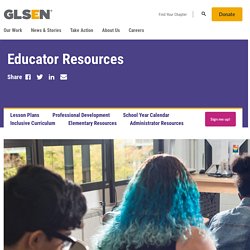
Through our Chapter-based Professional Development program, GLSEN offers tools and resources to thousands of educators who seek to make their classrooms and schools a safe place for all students. Based on 25+ years of experience and research, GLSEN boasts a robust educator training program with a series of modules curated to cover an array of topics suitable for a diverse range of audiences. GLSEN research shows that the presence of supportive educators can have a significant positive impact on LGBTQ students’ academic achievement, as well as on their psychological well-being and long-term educational aspirations. GLSEN Professional Development aims to empower educators to act in allyship with LGBTQ students. A teacher’s guide: Using social justice topics in the classroom. Topics surrounding human rights and equality can be thorny, but educators can use societal issues to create meaningful dialogue with students and enhance learning.

PYP teachers Kirsten Fournier, Kerri Irwin and Vivien Rosa-Vaccarelli tell us more. Race, gender and faith—there are not many more social justice topics that can elicit unease and uncertainty if not approached with some sensitivity. And while it’s important such topics are discussed with children, they raise many questions for teachers, such as: “What am I allowed to say?” 8 Powerful Ways to Promote Equity in the Classroom. Every student in my classroom deserves an equal chance.
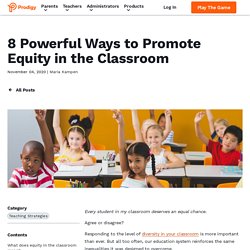
Agree or disagree? Responding to the level of diversity in your classroom is more important than ever. But all too often, our education system reinforces the same inequalities it was designed to overcome. Actively promoting equity in the classroom helps remove barriers so all of your students can succeed. 8 Engaging Ways Teachers Can Expose Students to Social Justice – LiveTiles. This website uses cookies We use cookies to personalise content and ads, to provide social media features and to analyse our traffic.
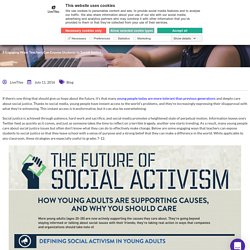
We also share information about your use of our site with our social media, advertising and analytics partners who may combine it with other information that you’ve provided to them or that they’ve collected from your use of their services. Necessary cookies only Allow selected cookie types Accept all Show details. Critical Media Project. Parable of the Polygons - a playable post on the shape of society.
This is a story of how harmless choices can make a harmful world. These little cuties are 50% Triangles, 50% Squares, and 100% slightly shapist. But only slightly! In fact, every polygon prefers being in a diverse crowd: 3 Ways to Build Empathy with Digital Tools. Personal Decision-Making for Community and Equity. Resource Guide by Kathy Adamonis Introduction This resource guide includes video, literature guides, activities, and lessons that may be used in order or selectively.
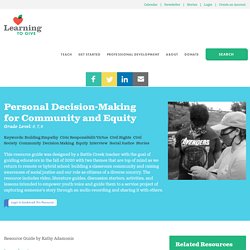
The discussions and lessons are intended to empower youth voice and guide them toward a service project of capturing someone's story through an audio recording and sharing it with others. The two themes: (22) Social Justice Belongs In Our Schools. (22) A Walk in My Shoes: Social Justice in Education Full Documentary. (22) 6 Ways to be an Antiracist Educator. (22) The N-Word in the Classroom. (22) An Argument Between Racist and Anti-Racist Ideas - Dr. Ibram X. Kendi.
10 Ways to Talk to Students About Sensitive Issues in the News. Michael Appleton for The New York TimesSybrina Fulton and Tracy Martin, the parents of 17-year-old Trayvon Martin, who was shot to death by a neighborhood watchman in Sanford, Fla., joined a protest in Union Square on March 21.
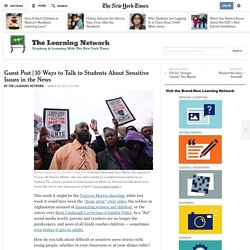
How do you talk about news stories like this in your classroom or at home? Go to related article » This week it might be the Trayvon Martin shooting, while last week it could have been the “Kony 2012″ viral video, the soldier in Afghanistan accused of massacring women and children, or the outcry over Rush Limbaugh’s criticism of Sandra Fluke: In a “flat” social media world, parents and teachers are no longer the gatekeepers, and news of all kinds reaches children — sometimes even before it gets to adults. How do you talk about difficult or sensitive news stories with young people, whether in your classroom or at your dinner table? What would you add? Guide to ThinkB4YouSpeak.
Digital Literacy and Youth Civic Engagement. Resources and Readings Erica Hodgin and Joe KahneCivic Engagement Research Group, Graduate School of Education, University of California—Riverside References:
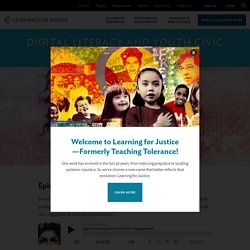
Social Justice Resources for Teachers. Here’s my Social Justice Resources to fire you up and inspire you.
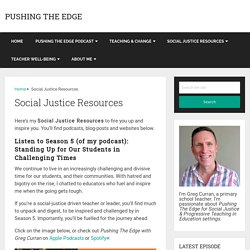
You’ll find podcasts, blog-posts and websites below. Listen to Season 5 (of my podcast): Standing Up for Our Students in Challenging Times We continue to live in an increasingly challenging and divisive time for our students, and their communities. With hatred and bigotry on the rise, I chatted to educators who fuel and inspire me when the going gets tough. The Leading Equity Podcast. The Power of Student Activism with Nakisha Hobbs - PTE022. In Episode 22: we explore the power of student activism in a K-8 elementary school in Chicago, USA Show Guest – Nakisha Hobbs Nakisha Hobbs Nakisha is the Principal and Co-founder of Village Leadership Academy in Chicago, USA.

It’s a school that is founded on the principle of social justice, and student activism plays a key role in the life of the school and the students. Resources - Youth Activism Project. YOUth ACTivism: Guide to Change Our free YOUth ACTivism: Guide to Change was written by teens for teens. It breaks down all the steps needed to start and execute a successful policy advocate campaign from the ground up. Girls Gone Activist! How to Change the World through Education Our free bilingual action guide, co-authored by experienced student activists with School Girls Unite, describes key elements for starting a campaign plus many clever advocacy stories that showcase video petitions, street theater and lobbying elected officials. 6 Youth-Led Political Movements to Inspire You to Vote.
To make an impact, a political movement needs good ideas and the ability to make them heard. To be successful, they need innovation and passion—and the ones profiled below seem to have an unlimited supply. Whether it's a high school student with an app that connects activists, a community leader with a gift for Twitter, or a Parkland survivor turning tragedy into action, young people are tackling tough problems with new—some might say disruptive—solutions. What Is Project LIT Community? Let's Do This! Youth + Social Change through Youth-Led Activism – Freechild Institute. An approach that intentionally trains young people in community organizing and advocacy, youth-led activism also assists children and youth in putting these skills to action in order to alter power relations and create meaningful change throughout their communities.
Through youth-led organizing, young people can employ activities such as political education and analysis, community research, campaign development, direct action, critical thinking and membership recruitment. How Youth Youth + Social Change Happens Through Youth-Led Activism Youth-Led Protests — When young people can’t find adult allies, when the organizations and communities they are part of deny youth voice, and when society doesn’t budge, protest might be the most viable option.
Youth-led protests can be the most powerful option children and youth have to transform society. There are countless protest activities, including sit-ins, picketing, #hashtags, walkouts, sit-ins, and more. Youth-Led Activism is Key to Building a Better World. This moment is urging us to continue to challenge and exit oppressive systems and work to build a better world using technology to aid us. Educators, families, and youth are reimagining school and engaging in new ways with virtual learning.
We are building community digitally with people we’ve never met in person and together still making change locally, fueling digital civic engagement. Lia Coyle, a 20-year-old participant in Public Achievement, explains that “online learning is not a system rooted in centuries of violence and oppression, so in this time we can work to build a new precedent and system.” Youth are building liberating systems by using their voices on issues shaping their lives, like Black Lives Matter, immigration rights, gun violence, education inequity, and climate justice.
Although 2020 and the pandemic have accelerated this youth-led digital civic engagement, this movement was happening before 2020 and will continue shaping the future of social change. YA Social Justice Books. Destiny Discover Search. Destiny Discover Search. Destiny Discover Search. Destiny Discover Search. Destiny Discover Search. Destiny Discover Search. Destiny Discover Search. Destiny Discover Search. Resource Roundup: Teaching and Curriculum Supports on Antibias and Social Justice. 20 of the Best Social Justice Books For Young Readers. Fostering Global Citizenship, Inclusion & Understanding - YALSA. A Collection of Resources for Teaching Social Justice.